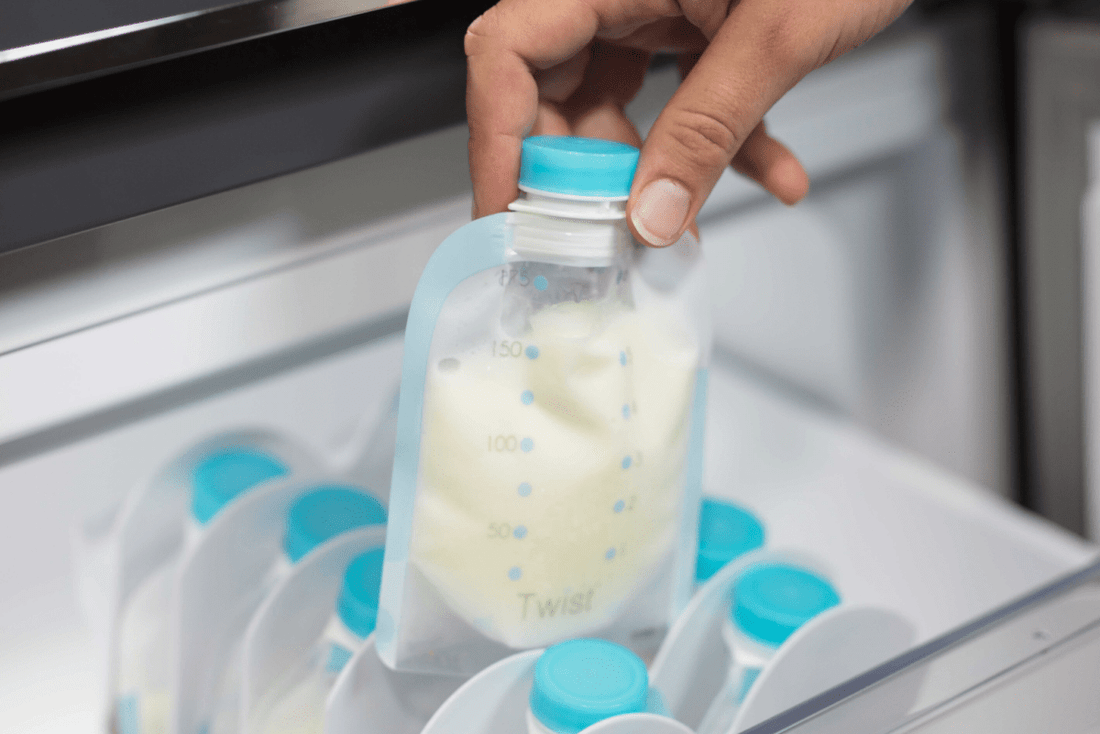
Breastmilk Storage Guidelines
Share
There are many different opinions on the topic of breastmilk storage guidelines, how do you know which to follow? It is hard to go wrong with evidenced based, research backed best practices. For those mothers who are strict pumpers, on the go, or are looking to stock up on your breastmilk, be sure to follow the current breastmilk storage guidelines below.
Storing Expressed Breast Milk

It is recommended to minimize milk transfers (which can be a risk for waste), by pumping directly into your intended storage container. There is no evidence that plastic or glass containers are better than the other, either are fine. If you have just expressed your breastmilk, it can be stored around room temperature (up to 77 degrees F) for no longer than 4 hours before needing to be refrigerated or frozen.
When it is time to refrigerate, fresh breast milk can live in your fridge for no longer than 4 days before needing to be used or frozen. Freshly expressed breast milk can also go in your freezer (0 degrees F/-18 degrees C) and is optimally used within six months, but can be frozen up to 12 months.
Evidence suggests mothers can mix warm milk and cold, and even combine or pool milk from 24 hours together. AAP research suggest this may even help even the variability in nutrients due to variances in each pump session.
Thawing and Warming Expressed Breast Milk
Once breast milk has been completely thawed (ice crystals are no longer present), it needs to be used with 24 hours. It can be refrigerated until you are ready to warm and feed. The CDC and the USDA recommend that the safest way to thaw and warm breast milk is to use warm, flowing water (140F/60C or below). This can be done by sitting your pouch under a stream of running water, placing the pouch in a cup or bowl of warm water, or using a circulating style of breast milk/bottle warmer (we recommend our Kozii SafeHeat Pro warmer).
Breast milk should never be steamed, boiled, or microwaved. Warming at high heats can destroy some of the nutrients in breast milk, as well as create hot spots which can scald your baby's mouth. Once breastmilk has been thawed and warmed, it should not be frozen again and should be used within the recommended guidelines.
Newest research from the American Academy of Breastfeeding medicine tells us that milk that has been warmed and fed to a baby is probably safe to use one more time, within 2 hours of the original feeding.
Feeding Expressed Breast Milk
Freshly expressed breastmilk can be fed to your baby right away. You can leave it at room temperature for up to 4 hours if the next feeding is within that time. If you are not going to use the milk within a couple of hours, it is a good idea to immediately refrigerate or freeze it. This prevents the breast milk from being left out past the recommended time, or accidentally knocked over (sometimes you do cry over spilled milk, if it's liquid gold!).
Handling of Expressed Breast Milk

Always wash your hands before expressing or handling expressed milk. Before pumping, inspect your parts for any possible defects. Always use a new breastmilk storage bag or clean food-grade containers, with tight-fitting lids made of glass or plastic.
Most breastmilk storage bags are single-use only and should NOT be rinsed and re-used. Your pump parts (flanges/breast shields and reusable collection containers) should be rinsed and washed after each pumping session (follow manufacturers' instructions). Check with your manufacturer for sterilization guidelines.
Always follow these breastmilk storage guidelines to protect your liquid gold!
Breastmilk Storage Guidelines – The Best Product for Exclusive Pumpers
At Kiinde, we are committed to all types of mothers out there who are in need of revolutionary and affordable breastfeeding resources. If you’re looking for the best products to help you follow these breastmilk storage guidelines, look no further than some of our top selling products for exclusive pumpers! One of our most popular products for exclusive pumpers when it comes to following breastmilk storage guidelines is the Twist Pouch, available in six ounces and eight ounces. The Twist Pouch boasts many innovative features, including:
- Leak free, transfer free pumping
- Contaminant-free, with no BPA, PVC, or phthalates
- Affordable pricing, especially with our free trial and subscription program
- Clear labeling for precise measurement
- Compatibility with major brands, with use of our Twist Adapter
- And more!
Breastmilk Storage Guidelines – The Most Popular Product for Working Moms
It can be tricky for mothers to remember and prioritize all of these breastmilk storage guidelines – especially if you are a parent who is constantly on the go. That is why we created our Anika Pump Bag. One of our most popular products among those mothers who are always on their feet, our Anika Pump Bag is equipped with a variety of features, including:
- Built in cooler for keeping your breastmilk the perfect temp
- Special pockets for tissues, pens, and parts of your pump
- Gold hardware for an overall classy, professional finish
- Thirteen inch pocket that can fit most laptops
- And more!
Whether you are working that nine to five or constantly on your feet, we are here to help make sure that you can best follow our breastmilk storage guidelines with our top selling Pump Bag!